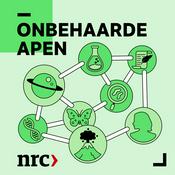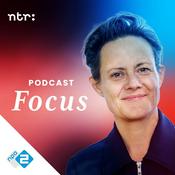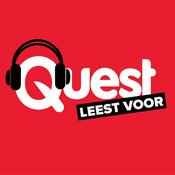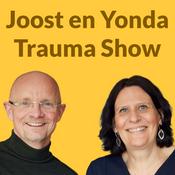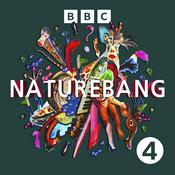Real Science Exchange-Dairy
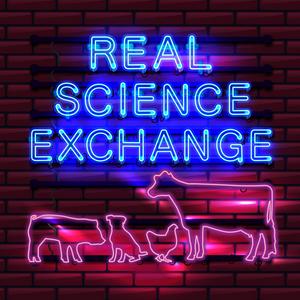
192 afleveringen

Legacy Series: Dr. Don Beitz; Guests: Dr. Don Beitz, Iowa State University; Dr. Jesse Goff, Iowa State University; Dr. Jim Drackley, University of Illinois; Dr. Corwin Nelson, University of Florida; Dr. Mike VandeHaar, Michigan State University
06-1-2026 | 50 Min.
In the Real Science Exchange Legacy Series, we celebrate the pioneers who have shaped the dairy industry. In this episode, we honor Dr. Don Beitz, a distinguished professor at Iowa State University. At the 2025 ADSA Annual Meeting, a symposium was held titled “Donald C. Beitz Recognition Symposium: 50-Plus Years of Dairy Science Research.” The guests on this episode, all former graduate students of Dr. Beitz, were speakers at the event. Join us as we explore Dr. Beitz’s contributions and enduring impact on our industry. Panelists introduce themselves and how they met Dr. Beitz. Tricky MS and PhD exam questions are also shared. Panelists emphasize Dr. Beitz’s love for biochemistry, teaching, and collaboration. (1:17)Dr. Beitz shares about his early life, academic career, and family. (11:45)Dr. Goff’s symposium presentation focused on Dr. Beitz and colleagues’ contribution to our understanding of transition cow hypocalcemia. He talks about studies on low calcium diets, investigating the metabolic pathways of vitamin D, and low phosphorus diets. Dr. Beitz also studied the impact of vitamin D on meat tenderness. (22:37)Dr. Nelson’s presentation detailed the advances in understanding bovine immunology from the work of Don Beitz and his colleagues. From the milk fever vitamin D research, it was also discovered that vitamin D had an impact on the immune system, which led to further work with vitamin A and immunity as well. Dr. Beitz also had students investigate calf growth rate influence on immune system development as well as Johne’s disease. (27:22)Dr. Drackley focused on Dr. Beitz’s work in understanding fatty liver and ketosis. The transition period was of interest to Dr. Beitz, which is reflected not only in his work in hypocalcemia, but also the lipid and carbohydrate metabolism of ketosis. Dr. Beitz and his colleague, Dr. Young, developed a successful ketosis model using a slight feed restriction and supplementing a ketone body precursor, which was used to investigate ketosis and fatty liver. (30:25)Dr. VandeHaar spoke about Dr. Beitz’s passion for research and teaching in dairy science, biochemistry, and life. He emphasized the depth and breadth of Dr. Beitz’s work and teaching. He shared that Dr. Beitz has served as major professor for around 107 graduate students and has taught biochemistry to over 16,000 students. (35:02)The panelists share stories about Dr. Beitz’s humility, care and support for students, and the many different professional societies he has been involved in over his career. (38:39)Panelists share their take-home thoughts. (42:56)Please subscribe and share with your industry friends to invite more people to join us at the Real Science Exchange virtual pub table. If you want one of our Real Science Exchange t-shirts, screenshot your rating, review, or subscription, and email a picture to [email protected]. Include your size and mailing address, and we’ll mail you a shirt.

Anomalies in Analyzed Nutrients, Guests: Dr. Glen Broderick, University of Wisconsin-Madison and Dr. Mary Beth Hall, The Cows Are Always Right LLC
30-12-2025 | 48 Min.
This episode features Dr. Glen Broderick and Dr. May Beth Hall, speakers at the 2025 ADSA Ruminant Nutrition Symposium: Anomalies in Analyzed Nutrient Composition of Feedstuffs.Dr. Broderick’s presentation was titled “Protein analysis methodology.” The high points of his talk include recommendations for nitrogen analysis in feeds, potential improvements in determining protein degradability and undegradability in the rumen, and near-infrared spectroscopy (NIR) analysis of amino acid composition of feedstuffs. (7:57)Dr. Hall’s presentation was titled “Success and continuing challenges in analyzing nonfiber carbohydrates.” She gives some history of the analysis of non-fiber carbohydrates and talks about starch assays and how water-soluble carbohydrates are not solely composed of sugars. She also explains how microbes make decisions on which substrates to ferment and which to store for later. (12:47)The panelists talk about challenges in obtaining real-time nutrient analyses in order to make ration changes. They recommend using rolling averages rather than a single sample and using milk urea nitrogen as a way to evaluate if something is not quite right with a ration. (21:17)Dr. Broderick notes he recommends that scientists no longer use the Kjeldahl method of nitrogen analysis, that we look for new or alternative methodology other than in situ digestibility to determine protein degradability, and that NIR analysis of amino acids be used to make ration decisions when calibrated for the feedstuff under consideration. (27:10)Dr. Hall recommends using the appropriate carbohydrate standard when measuring water-soluble carbohydrates: sucrose for fresh forages, fructose for cool-season grasses with high fructan content, etc. She also notes that some feeds, like bakery waste or amylase-modified grain, contain soluble starch, which shows up in both the starch category and the water-soluble category in a feed analysis, essentially double-dipping. Lastly, she suggests that nonfiber carbohydrates remain a bit of a nutritional black box and we continue to learn more with improved technology. (29:36)Panelists share their take-home thoughts. (43:31)Please subscribe and share with your industry friends to invite more people to join us at the Real Science Exchange virtual pub table. If you want one of our Real Science Exchange t-shirts, screenshot your rating, review, or subscription, and email a picture to [email protected]. Include your size and mailing address, and we’ll mail you a shirt.

Creating Carbon-Friendly Cows; Guest: Dr. Jocelyn Johnson, STgenetics; Co-host: Dr. Ryan Pralle, Balchem
23-12-2025 | 25 Min.
This episode features Dr. Jocelyn Johnson with STgenetics, a speaker at the 2025 ADSA Breeding and Genetics Symposium: Creating Carbon-Friendly Cows and Leveraging Omics to Improve the Sustainability of Dairy Production.Dr. Johnson’s presentation was titled “Advancing dairy sustainability through feed-efficient genetics and genomics: Research insights and applications.” She gives an overview of her talk, which focused on data STgenetics has collected and how the company has applied that data to help their customers be more sustainable. She goes on to describe some of the residual feed intake research they’ve conducted in dairy cows. (4:20)STgenetics has invested in feed efficiency technology and has shown that selection for improved feed efficiency is correlated to a lower carbon footprint. Dr. Johnson talks about the heritability of feed efficiency compared to other traits we select for in the dairy industry. (8:16)Dr. Pralle asks Dr. Johnson if STgenetics is measuring emissions from cows in their research. The company has partnered with Texas A&M to measure methane emissions in heifers divergently selected for feed efficiency. They found that more efficient animals produced less methane. Since that pilot project, STgenetics has purchased equipment to measure emissions at their own research facilities and has collected 2-3 years of data on beef, beef on dairy, and Holstein populations. Dr. Johnson emphasizes that the relationship between methane emissions and high milk production is somewhat of a balancing act. (11:29)The group discusses feed additives purported to decrease methane emissions and the differences in rumen microbiomes between high and low efficiency animals. They also talk about how best to get information and technology in front of producers. (17:59)Panelists share their take-home thoughts. (23:39)Please subscribe and share with your industry friends to invite more people to join us at the Real Science Exchange virtual pub table. If you want one of our Real Science Exchange t-shirts, screenshot your rating, review, or subscription, and email a picture to [email protected]. Include your size and mailing address, and we’ll mail you a shirt.

The Future of Milk; Guests: Eve Pollet, Dairy Management Inc.; Dr. John Lucey, University of Wisconsin- River Falls; Dr. Rafael Jimenez-Flores, Ohio State University; Dr. Jim Aldrich, CSA
16-12-2025 | 1 u. 7 Min.
Eve gives an overview of current and future consumer trends where dairy can play a role. Functional foods, health and wellness, high protein foods, fermented and cultured foods, women’s health, brain health, and aging are all part of the mix. (7:26)The panelists discuss the healthfulness of saturated fats, the resurgence of butter, milk’s bioactive compounds, and how best to reach the public about the health benefits of dairy. (10:41)Eve talks about marketing to Gen Z consumers, who are motivated by novelty. How do we reimagine a food that’s been here for thousands of years? What new ways can we talk about it? What ways can we optimize dairy science and research to show up in generative systems like ChatGPT? (20:34)The group then tackles the topic of lactose. Lactose and honey are the only two sugars not made by plants. Why is it lactose that is in the milk of mammals? Dr. Jiminez-Flores thinks lactose is a dark horse in dairy and we have much yet to discover about it. He notes that some milk oligosaccharides are not digested by babies, but are used by bacteria in the development of a healthy microbiome. Dr. Lucy notes that dairy also contains peptides that have been found to reduce hypertension. The group also delves into how dairy products can be part of preventative health care. (23:53)Do consumers perceive dairy products to be minimally processed? Eve explains that dairy is perceived as a clean, fresh food. Given the current trend to reduce additives and food dyes, she sees potential for dairy food science innovation in this area. Dr. Aldrich talks about the glycemic index of lactose-free milk. (38:13)The panelists agree that dairy has a great upcycling story to tell. Converting fiber into milk and meat and feeding non-human grade byproducts are just two examples. Eve notes that younger consumers care about sustainability, but there’s a huge “say-do” gap: 76% of North American consumers identify as caring about conscious and sustainable practices, but less than 40% actually act on those values when making purchases. The panel also notes that whey is another great upcycling story. Dr. Jiminez-Flores emphasizes how important consumer trust in science and research is, and how we are currently experiencing a loss of that trust. (45:48)Panelists share their take-home thoughts. (1:01:01)Please subscribe and share with your industry friends to invite more people to join us at the Real Science Exchange virtual pub table. If you want one of our Real Science Exchange t-shirts, screenshot your rating, review, or subscription, and email a picture to [email protected]. Include your size and mailing address, and we’ll mail you a shirt.

Got (More) Milk? The Latest Research on Fueling Dairy Cows with High-Oleic Soybeans; Guests: Dr. Adam Lock, Michigan State University; Dr. Alycia Bales and Nathan Elzinga, Caledonia Farmers Elevator; Co-host: Dr. Jeff Elliott, Balchem
09-12-2025 | 1 u. 4 Min.
Dr. Lock presented a Real Science Lecture Series webinar on June 3, 2025. This episode takes a deep dive into the current science and applications of feeding high-oleic soybeans in dairy diets. You can find the original webinar at balchem.com/realscience. Dr. Lock gives an overview of the evolution of our knowledge of biologically important fatty acids in dairy cows. Much like we think more about amino acids than crude protein these days, we are starting to think about fatty acids rather than crude fat. There are 5 main fatty acids in dairy cow diets: palmitic, stearic, oleic, linoleic, and linolenic. Dr. Lock talks about the importance and role of each, especially that of oleic acid. (6:26) Dr. Bales shares some of the research she conducted in Dr. Lock’s lab during her MS and PhD, including a dose response study, raw versus roasted beans, and roasted beans plus supplemental palmitic acid. All studies have resulted in increased milk fat and milk yield, better feed efficiency, and usually a bump in milk protein. She also notes there is a nice synergistic relationship between the fat and degradable protein in the roasted high-oleic beans, which are high in lysine. (13:59)Nate talks a bit about how the elevator positions high-oleic soybeans to the dairy producers in the area and how different farms have implemented feeding the beans, depending on size, infrastructure, and location. Dr. Bales chimes in with some additional examples. (21:02)The panelists agree that quality control to ensure consistent sources going out into the field is the next big hurdle. Finding the optimal particle size for diets is also needed, as there is a wide variation currently, which may impact cow performance. (31:56)Nate predicts no slowing down in the adoption of this technology in his area in the next few years. Dr. Lock notes there may be some potential for feeding high-oleic oil in areas not suited for growing the beans themselves. The panelists agree that the target groups who should receive high-oleic beans in their rations are fresh cows and high cows. Nate emphasizes the importance of having adequate digestible NDF and a healthy rumen to see optimal results. (37:10)Dr. Lock talks about future research plans into high-oleic soybeans and other fatty acids. The panel comments on the yield of high-oleic soybeans and the availability of seed, both conventional and GMO. (48:48)Panelists share their take-home thoughts. (59:15)Please subscribe and share with your industry friends to invite more people to join us at the Real Science Exchange virtual pub table. If you want one of our Real Science Exchange t-shirts, screenshot your rating, review, or subscription, and email a picture to [email protected]. Include your size and mailing address, and we’ll mail you a shirt.
Meer Wetenschap podcasts
Trending Wetenschap -podcasts
Over Real Science Exchange-Dairy
Luister naar Real Science Exchange-Dairy, Boring History for Sleep en vele andere podcasts van over de hele wereld met de radio.net-app

Ontvang de gratis radio.net app
- Zenders en podcasts om te bookmarken
- Streamen via Wi-Fi of Bluetooth
- Ondersteunt Carplay & Android Auto
- Veel andere app-functies
Ontvang de gratis radio.net app
- Zenders en podcasts om te bookmarken
- Streamen via Wi-Fi of Bluetooth
- Ondersteunt Carplay & Android Auto
- Veel andere app-functies


Real Science Exchange-Dairy
download de app,
luisteren.

